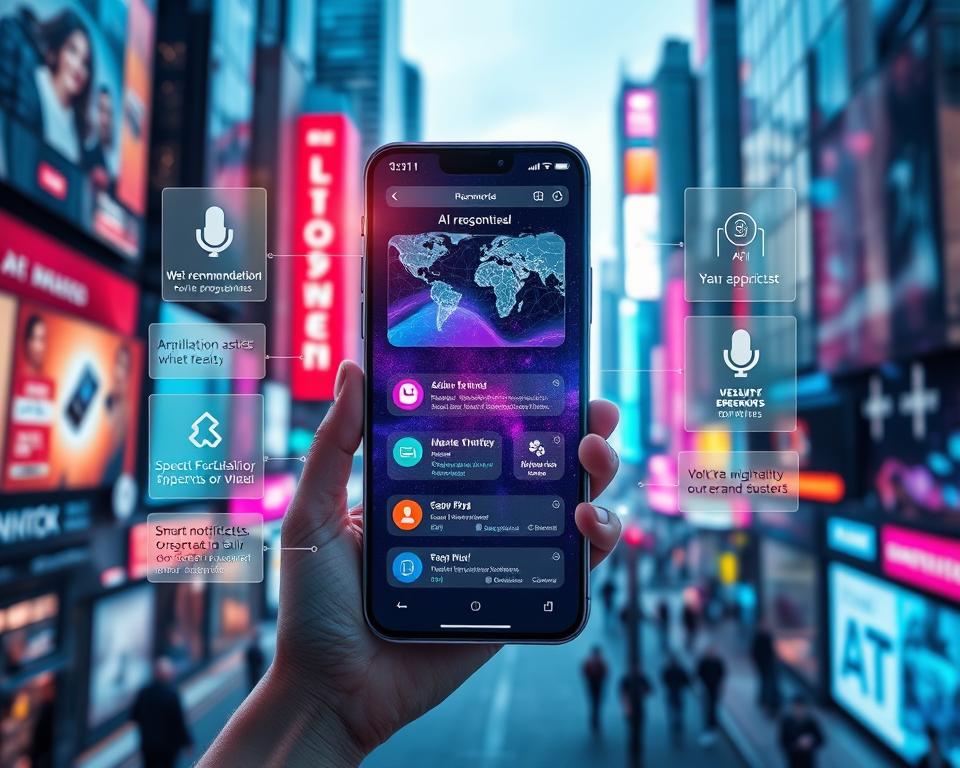The digital world is changing fast, and AI is at the heart of this change. It’s making our smartphones smarter and more interactive. This guide will teach you how to make AI-based mobile apps. You’ll learn how to create apps that are smart and fun to use.
AI apps use advanced tech like machine learning and neural networks. These tools help apps understand, learn, and make smart choices. With AI, apps can get to know you better, do things for you, and suggest things you might like. This makes using apps a better experience.
This guide will cover everything you need to know to start making AI apps. We’ll talk about the basics of AI apps, the tools you’ll need, and how to use them. You’ll learn how to turn your ideas into reality and make the most of AI in your apps.
Table of Contents
Key Takeaways
- Gain a comprehensive understanding of the core components and key benefits of AI-based mobile applications.
- Explore the latest market trends and industry advancements in the realm of AI-integrated mobile apps.
- Discover the essential tools, technologies, and development platforms required for building AI-powered mobile applications.
- Learn how to effectively integrate machine learning models, natural language processing, and computer vision capabilities into your mobile apps.
- Understand the best practices for data management, testing, and performance optimization to ensure the success of your AI mobile applications.
Understanding AI-Based Mobile Applications Fundamentals
The world of mobile apps is changing fast, thanks to AI. AI apps offer smart features that go beyond what old apps can do. At the heart of these apps are deep learning, computer vision, and natural language processing. These technologies are making mobile computing better.
Core Components of AI Mobile Apps
AI apps have several key parts that work together. They include:
- Machine learning models for recognizing patterns and making predictions
- Computer vision algorithms for detecting images and objects
- Natural language processing (NLP) for understanding text and chatting
- Contextual awareness and personalization engines for customizing the app for each user
Key Benefits of AI Integration
AI in mobile apps offers many benefits. It changes how we use our devices. Some main advantages are:
- It makes the app smarter and more personal
- It helps with making better decisions and solving problems
- It makes things run smoother and faster
- It keeps the app and data safer from fraud
Current Market Trends
More people want AI apps, and businesses are taking notice. Experts say the AI app market will grow a lot. This growth is because of deep learning, computer vision, and natural language processing in many apps.
| AI Mobile App Segment | Projected Growth (CAGR) | Key Driving Factors |
|---|---|---|
| Retail and e-commerce | 28.5% (2022-2027) | Personalized product recommendations, virtual assistants, and image recognition |
| Healthcare and fitness | 25.3% (2022-2027) | Remote patient monitoring, medication management, and workout personalization |
| Banking and finance | 23.7% (2022-2027) | Fraud detection, investment analysis, and personalized financial advice |
Essential Tools and Technologies for AI App Development
Creating AI apps needs strong tools and tech. Developers use machine learning frameworks, neural network libraries, and deep learning platforms. These resources help build smart AI features in mobile apps.
Popular Machine Learning Frameworks
Frameworks like TensorFlow, PyTorch, and Keras help developers. They offer tools and APIs for building and deploying machine learning models on mobiles. These frameworks support many models, including neural networks and decision trees.
Neural Network Libraries
Libraries like CoreML, TensorFlow Lite, and Caffe2 add deep learning to mobile apps. They make neural networks work well on devices, ensuring AI features run smoothly.
Deep Learning Platforms
Platforms like Google’s MLKit and Apple’s Vision Framework make AI easy to add to apps. They offer pre-trained models and simple APIs. This lets developers use advanced AI without needing to be experts.
| Tool/Technology | Description | Key Features |
|---|---|---|
| TensorFlow Lite | A lightweight version of the TensorFlow machine learning framework, optimized for mobile and edge devices. |
|
| CoreML | Apple’s framework for integrating machine learning models into iOS, iPadOS, and macOS applications. |
|
| Google MLKit | A suite of on-device machine learning APIs provided by Google, designed for mobile app development. |
|
Using these tools, developers can make AI apps that are smart and fun. They can create apps that really understand and interact with users.
Setting Up Your Development Environment
To start making AI-based mobile apps, you need a good development setup. We’ll look at the key software, SDKs, hardware, and platforms for your project.
Required Software and SDKs
First, make sure you have the right software and SDKs on your machine. You’ll need an Integrated Development Environment (IDE) like Android Studio or Xcode. Also, get the AI and machine learning frameworks, such as TensorFlow Lite, Core ML, or PyTorch Mobile.
Hardware Requirements
For AI apps, you need more powerful hardware than usual. Get a laptop or desktop with a dedicated graphics processing unit (GPU). This helps with the complex calculations needed for AI. Also, make sure you have enough RAM and storage for your tools, SDKs, and AI features.
Development Platforms Selection
- For Android apps, use Android Studio with TensorFlow Lite.
- For iOS apps, choose Xcode for Core ML and other frameworks.
- Tools like Flutter and React Native let you build apps for both Android and iOS.
Choose your platform wisely. Make sure your setup is ready for AI app development and machine learning.
How to develop AI based Mobile Applications, AI based Apps development
Creating AI-based mobile apps is a smart move for businesses. It lets them use predictive analytics, intelligent chatbots, and augmented reality. These technologies help make apps that are more personal, automate tasks, and improve how customers interact with them.
Building AI-powered mobile apps takes several steps. Here are the main stages:
- Ideation and Requirement Gathering: First, figure out the problem your app will solve. Decide on AI features like predictive analytics, chatbots, or augmented reality. These will make your app better and meet your audience’s needs.
- Technology Selection: Pick the right AI frameworks and platforms for your app. TensorFlow Lite, Core ML, and Amazon Lex are good choices for adding AI.
- User Interface Design: Make your app’s design both good-looking and easy to use. It should work well with the AI features you’ve chosen.
- Data Collection and Preprocessing: Get the data needed to train your AI models. This data is key for making your app’s analytics, chatbots, and augmented reality work well.
- Model Training and Integration: Use the data to train your AI models. Then, add them to your app. Keep improving the models to make your app better.
- Testing and Validation: Test your app well to check its functionality and user experience. Use feedback to make it even better.
- Deployment and Maintenance: Put your app out there and watch how it does. Keep it updated and fix any problems to keep users happy.
By following these steps, you can make AI-based mobile apps. These apps use predictive analytics, chatbots, and augmented reality. They offer new and exciting ways to interact with users.
| AI-Based Feature | Key Benefits | Relevant Technologies |
|---|---|---|
| Predictive Analytics | Personalized recommendations, proactive decision-making, and enhanced customer experiences | TensorFlow Lite, Core ML, Amazon Sagemaker |
| Intelligent Chatbots | Automated customer support, 24/7 assistance, and seamless user interactions | Amazon Lex, DialogFlow, IBM Watson |
| Augmented Reality | Immersive product visualization, interactive tutorials, and engaging in-app experiences | ARKit, ARCore, Vuforia |
By adding these AI features, your mobile apps will be unique. They’ll offer personalized experiences, boost productivity, and keep users engaged.
Implementing Machine Learning Models in Mobile Apps
The mobile app world is changing fast. Machine learning models are key to making apps smarter and more personal. They help apps learn and make better choices, improving how users feel about them.
Popular ML Frameworks
Developers have many strong frameworks to choose from for machine learning in mobile apps. TensorFlow Lite, Core ML, and PyTorch Mobile are among the most used. These frameworks make it easy to add smart features to apps, helping them make quick decisions.
Model Training Best Practices
- Make sure your training data is top-notch to get the best machine learning models.
- Try out different machine learning models and neural networks to see what works best for your app.
- Make your model small and efficient so it runs well on phones.
- Keep updating your models to meet changing user needs and data.
Integration Techniques
Adding machine learning models to apps needs careful planning. You can use on-device inference or cloud-based inference. The choice depends on the model’s size, how sensitive the data is, and what the user wants.
| ML Framework | Supported Platforms | Inference Approach |
|---|---|---|
| TensorFlow Lite | Android, iOS | On-device |
| Core ML | iOS | On-device |
| PyTorch Mobile | Android, iOS | On-device |
“Integrating machine learning into mobile apps allows developers to create intelligent, personalized experiences that truly delight users.”
Natural Language Processing Integration
Mobile apps are getting smarter with the help of natural language processing (NLP). NLP lets apps understand and talk back to us, making interactions smooth and fun.
Text analysis is a big deal in mobile apps with NLP. Apps can now read what we write, like reviews or messages. This helps developers know what we like and what we don’t, making their apps better.
NLP also brings sentiment analysis to the table. Apps can now feel our emotions, whether we’re happy, sad, or neutral. This lets them respond in a way that feels right for us.
With NLP, apps can understand and answer our questions in our own words. This makes talking to apps feel more natural and helpful.
The coolest thing about NLP in apps is intelligent chatbots. These AI friends can chat with us, help us out, and even guide us through tough tasks. They get what we mean and keep the conversation going smoothly.
As we want apps to be easier to use, NLP is key. It helps developers make apps that are smarter, more helpful, and more fun for us.
| NLP Capabilities | Benefits for Mobile Apps |
|---|---|
| Text Analysis | Gain insights into user sentiment, preferences, and pain points |
| Sentiment Analysis | Personalize responses and provide empathetic support |
| Language Understanding | Enable conversational interactions and natural language queries |
| Intelligent Chatbots | Offer personalized assistance and seamless user experiences |
“The integration of natural language processing in mobile apps is a game-changer, empowering developers to create more intelligent, responsive, and delightful user experiences.”
Computer Vision Features Implementation
The world is moving fast towards artificial intelligence (AI). Mobile apps now use computer vision, changing the game. We’ll look at how to add computer vision features, like image recognition and augmented reality (AR).
Image Recognition Systems
Image recognition is key in mobile apps. It uses deep learning to understand images. This lets apps spot objects, faces, and text.
Thanks to modern phones, adding these features is easy. It makes apps more fun and useful for users.
Real-time Object Detection
Now, apps can detect objects in real-time. This tech watches what’s around you and tracks it. It’s great for many things, like better navigation and fun games.
AR Implementation Guidelines
Augmented reality (AR) makes apps even more exciting. It adds digital stuff to the real world. But, developers need to follow some rules to make it work well.
They should make sure it looks real and works smoothly. This way, users get the best AR experience.
AI in mobile apps is getting better all the time. With computer vision, we’re seeing new ways to use our phones. Developers are making apps smarter and more fun.
“Computer vision is the future of mobile app development, empowering users with innovative visual experiences and redefining the way we interact with our devices.”
Building Intelligent Chatbots for Mobile Apps
In today’s fast-changing mobile world, intelligent chatbots are changing how we talk to our phones. These smart interfaces use natural language processing (NLP) to make our interactions smoother and more fun.
To make great chatbots, developers need to know a lot about how people talk and think. They must also keep up with NLP’s latest tech. This way, chatbots can understand us better, know what we want, and answer smartly.
- Conversational design: Crafting intuitive and natural dialogues that align with user expectations and preferences.
- NLP integration: Leveraging state-of-the-art NLP algorithms to enable accurate language understanding and generation.
- Contextual awareness: Developing chatbots that can adapt their responses based on user history, location, and other relevant data points.
- Personalization: Tailoring the chatbot’s personality and tone to match the overall brand identity and user preferences.
Intelligent chatbots in mobile apps make users happier and open new chances for businesses. They help with customer service, make things easier, and can even make money. As people want more personal and easy-to-use interactions, chatbots will be key in apps soon.
“Chatbots are the future of mobile app interactions, offering users a seamless and intelligent way to engage with their devices.”
Mobile app makers who keep up with chatbot tech can give users amazing experiences. This helps them stand out and win over users.
Data Management and Processing for AI Apps
Artificial intelligence (AI) is becoming more popular in mobile apps. Handling and processing data is key for developers. It’s vital for using predictive analytics and machine learning models in AI apps.
Data Collection Methods
Getting good data is the first step for AI apps. Developers use many ways to collect data, like:
- In-app user interactions and tracking
- Using external data sources, like APIs and cloud services
- Mobile device sensors, like location and camera
- User-generated content
Storage Solutions
AI apps need big storage to handle lots of data. Developers look for scalable storage, like:
- Cloud services, such as Amazon S3 or Google Cloud Storage
- NoSQL databases, like MongoDB, for unstructured data
- Distributed file systems, like HDFS, for big data
Security Considerations
Data security is crucial for AI apps. Developers must protect user data with:
| Measure | Description |
|---|---|
| Encryption | Encrypting data in transit and at rest |
| Access Control | Strong user authentication and authorization |
| Compliance | Following data privacy laws, like GDPR |
By tackling data management, developers can make AI apps. These apps use predictive analytics and machine learning safely and securely.
Testing and Quality Assurance for AI Applications
Creating AI-based mobile apps needs careful testing and quality checks. This ensures the apps work well and are accurate. Since these apps use machine learning, it’s key to test these models and their predictions.
Developers must use a detailed testing plan. This plan covers important areas:
- Model Validation: It’s vital to test AI models’ accuracy and strength. This includes cross-validation, A/B testing, and stress testing to see how they perform under different situations.
- Prediction Accuracy Assessment: It’s crucial to check how well AI models predict things. Developers should use validation tools to see if the models make correct decisions.
- Usability and Functionality Testing: Making sure AI features work well and are easy to use is important. This means testing how the app responds, its interface, and how it works with other parts.
- Security and Privacy Compliance: Since AI apps handle personal data, they must be tested for security and privacy rules.
By following a strict testing and quality assurance plan, developers can make AI based apps development that are trustworthy and user-friendly. This builds trust and encourages more use of machine learning models in mobile apps.
“Quality is not an act, it is a habit.” – Aristotle
Performance Optimization Techniques
As AI-based mobile apps grow in demand, making them run well is key. We’ll look at ways to improve memory, speed, and battery life. This ensures your apps work great on mobiles.
Memory Management Strategies
Good memory management is essential for AI apps. They use a lot of data and complex models. Here are some tips to use memory wisely:
- Choose data structures and algorithms that save memory
- Use on-device caching to cut down on data fetching
- Load content only when needed with lazy loading and data streaming
- Keep an eye on memory use to find and fix leaks
Processing Speed Enhancement
Speeding up AI apps is vital for a good user experience. Here are ways to make your apps faster:
- Use AI frameworks like TensorFlow Lite and Core ML for better performance
- Send hard tasks to the cloud or edge devices for faster processing
- Make data prep and model inference faster to cut down on delays
- Keep working on your models to make them run faster
Battery Consumption Optimization
AI apps use a lot of power, so saving battery is important. Here are some tips to help:
- Use power-saving algorithms and data handling methods
- Use low-power modes and background tasks for less important work
- Reduce network use by cutting down on data and using offline features
- Control device sensors and hardware to save energy
By using these tips, you can make AI apps that are fast, smooth, and don’t drain the battery.
Deployment and Maintenance Strategies
Deploying and keeping AI-based mobile apps running well needs a smart plan. This plan ensures the app stays popular and users keep coming back. The first step is to submit the app to stores like Apple’s App Store or Google Play Store. Here, developers must follow the rules set by these platforms.
Using continuous integration and delivery (CI/CD) helps a lot. It makes updating and fixing bugs easier. With good CI/CD pipelines, teams can automate many steps. This means new features and fixes can be released smoothly.
Keeping AI apps up-to-date is also key. Developers need to update the AI models and features often. This keeps the app fresh and meets changing user needs and trends. By doing this, the app stays exciting and useful for users.














